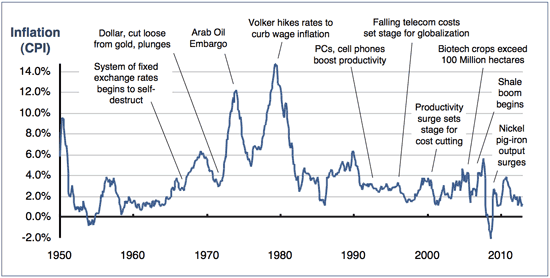Innovation Is Taming Inflation
Since 1926 inflation has averaged about 3% per year, reflecting the rising costs of housing, transportation, medical care, education, recreation, food and energy. So what happens when technology simultaneously increases competition and cuts the costs of providing those goods and services? Over the last two decades we’ve enjoyed elevated levels of productivity thanks to better information management and increased automation, both of which appear to be ongoing trends. In contrast, the ability to do things differently has produced only modest economic benefits up so far. But going forward, new forms of competition stand to have a growing impact on the economy, perhaps holding the normal rate of inflation within the current range of 1-2% (even as employment and GDP grow at faster rates).

Background
Over long periods of time, advancing technology has a way of turning scarcity into abundance. In the early 1800s, it took several hours of wages to pay for an hour of night-time candlelight. Today, the cost of running a lightbulb for the same length of time is about one cent, or roughly two seconds of work at the average wage. A century ago, it took a day’s wages to buy a pencil, versus roughly 30 seconds of work today. Around 1900, when bicycles enjoyed growing popularity, a basic model required about one month’s wages. Today you can buy a much safer model with multiple gears for about one day’s work. These dramatic reductions in real costs (5000x for illumination, 1000x for writing, 25x for getting around) were achieved largely at the hands of early technology -- motors, generators and automation machinery invented during the Industrial Revolution.
Today’s innovations, drawing on high-tech process control, data analysis and genetic manipulation, have much greater potential because they open the door to doing things that have never been done before. We’ve barely scratched the surface on this front, but where we have there are big impacts. Thanks to hydrofracking, an abundance of US oil is now driving fuel costs down globally. Thanks to nickel pig-iron, China has been able to boost stainless steel production without being constrained by limited supplies of high-grade nickel. And thanks to high-tech agricultural seeds, global food production is rising faster than demand. With these three innovations alone, the long-term rate of inflation may now be running a full percentage point lower -- maybe even more.
Going forward, advances in biotech are poised to revolutionize medicine. Nano-tech holds the promise of amazing new low-cost materials. The cost of experimenting with prototypes is falling thanks to software-controlled machinery (and now 3D printing). Because today’s technology can do powerful things with relatively low capital costs, anyone who has a great idea now has the ability to run with it. In coming decades there will be millions of great ideas disrupting the status quo, making scarce things abundant and allowing the impossible to become possible.
Impact
As technology drives down costs while creating new competition where none currently exists, prices for many low-tech things could start to behave like high-tech commodities, meaning that deflationary trends could become the norm for goods and services that normally see rising costs over time. Fuel, food, consumer products and vehicles could be the first to reverse course. As software becomes increasingly powerful, competition in the service sector could be next.
Ultimately, housing may slip into gradual decline. Driverless vehicles and work-at-home jobs will make it easier for employees to live further away from expensive housing markets, and flexible systems will make it easier for employers to set up shop in lower-cost regions. At the same time, construction costs will fall as modularization takes hold, and the supply of land that can be developed will multiply once electricity and water can be cheaply produced on site without any need for local utilities.
Investment Implications
The real estate bust may have brought inflation down to today’s low levels, but advancing technology and new competition is likely to keep it there. It should be no surprise if 1% becomes a new norm, and within a decade or two it’s within the realm of possibilities that a small amount of deflation could co-exist with a healthy rate of GDP growth (as is the case with high-tech manufacturing today).
What might this mean for stocks and bonds over the long run? Traditionally, investment-grade bonds tend to deliver returns 2-3 percentage points above the rate of inflation, whereas stocks tend to deliver 6-7 points of real returns. If we are now looking at 1% inflation instead of the historical 3%, future returns for stocks and bonds must fall by two points as well. That suggests forward returns in the range of 3-4% per year for bonds, and 7-8% for stocks. At first glance, it may seem that we face leaner returns in future years. However, the main purpose of investing is to grow one’s purchasing power with as little risk as possible. Because real growth rates may not change much, and stock market volatility may even decline as a new era of stable energy prices takes hold, risk-adjusted returns could actually improve. In other words, those who don’t mind lower absolute rates of return may be able to sleep better at night, while those who seek a traditional 10% per year from stocks may be able to get there by investing a tad more aggressively. ![]()

Jack Bowers
President & Chief Investment Officer